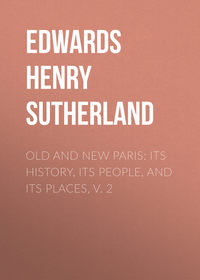 полная версия
полная версияOld and New Paris: Its History, Its People, and Its Places, v. 1
It must here be mentioned that at the foot of the tower is a statue of Pascal, who continued from its top the observations he had begun from the summit of the Puy de Dôme. The writer Nicholas Flamel, librarian to the University of Paris, and Pernelle, his wife, both buried in the vaults of Saint-Jacques-la-Boucherie, had been the benefactors of this church; and their memory is preserved in the name, Nicholas Flamel, given to the street which, beginning on the right of the tower, leads from the Rue de Rivoli to the Rue des Lombards.
Around the tower of Saint-Jacques is a large square, well planted with trees. Further on, towards the east, the Rue de Rivoli runs past the Hôtel de Ville and the Napoleon Barracks. Of the Church of Saint-Gervais, one side of which looks towards the Rue de Rivoli, mention has already been made. Close to the point where the Rue de Rivoli and the Rue Saint-Antoine meet, is an offshoot from the Rue Saint-Antoine called Rue François Miron, after the independent provost of merchants under the reign of Henri IV. In this street stands the Hôtel de Beauvais. From the windows of this mansion Anne of Austria, accompanied by the Queen of England, Cardinal Mazarin, Marshal Turenne, and other illustrious personages, witnessed the procession headed by her son, Louis XIV., and her daughter-in-law, Marie Thérèse of Austria, when the newly married couple made their solemn entry into Paris through the Gate of Saint-Antoine, August 26, 1660.
Running from the Rue Saint-Antoine to the Rue Charlemagne is a narrow street scarcely twelve feet broad, with walls of extraordinary height. Rue Percée it was originally named. For some years past it has been called Rue du Prévôt, because at its south-east corner it joins the former mansion of the Provost of Paris, of which the principal entrance is in the Rue Charlemagne. The series of open courtyards known as the Passage Charlemagne, in which all sorts of trades are carried on, lead to the very centre of one of the most interesting and least known monuments of old Paris. It is composed of two blocks of parallel buildings constructed in the style of the first years of the sixteenth century, when French architects were beginning to throw aside the fantasies of Gothic art to subject themselves to the straight lines of the Neo-Roman style. After passing through various hands, and finally from François Montmorency, Governor of Paris, to Cardinal Charles de Bourbon – the structure was presented by the latter to the Jesuits, who attached to it a chapel dedicated to St. Louis and St. Paul. The Church of St. Louis and St. Paul possesses, among various works of modern art, the first picture known to have been painted by Eugène Delacroix: “Christ in the Garden of Olives.” This work is dated 1816.
The house given to the Jesuits was taken from them in 1767 on their expulsion from France, and it then became the general repository of all maps, plans, and other documents relating to the French navy, and at the same time the Library of the Town of Paris. A passage leading from the Rue Saint-Antoine to the Rue Saint-Paul separated formerly the Church or Chapel of Saint-Éloi, where Charles VI. was baptised, from the cemetery of the same name, where the man in the iron mask, under the name of Marchiali, was buried. Here, too, Rabelais, Hardouin, and Mansard, the architect, were interred. Rabelais died on the 9th of April, 1553, in the Rue des Jardins, not very far from the mercers’ house where Molière went to live nearly a century later.
The Rue Saint-Antoine was interrupted, until the Revolution of 1789, by the Bastille. This fortress was composed of eight towers, four looking towards the Town, that is to say towards the Rue Saint-Antoine, and four towards the country, that is to say the Faubourg Saint-Antoine. Curiously enough it was no despot, but Étienne Marcel, Provost of the Merchants, who built the original Bastille, destined afterwards to be enlarged (in 1370) by Hugues Aubriot, Provost of Paris.
It was from the Hôtel de la Rochepot, in the Rue Saint-Antoine, that Henri II. was accustomed to view the burning at the stake of his Protestant victims. In this street, too, was one of the earliest of the Protestant places of worship established in France at the very beginning of the Reformation. Few persons are aware, though the fact has been pointed out by M. Athanase Coquerel the younger, that the Reformation of the sixteenth century, before breaking out in Germany and elsewhere, had already appeared in Paris. It had for cradle the left bank of the Seine separated at the time from the town and its suburbs, and divided into quarters subject to two special jurisdictions: the University and the vast territory of the Abbaye of Saint-Germain-des-Prés. Was it not natural, asks M. Coquerel, in spite of the jealous vigilance of the Sorbonne, that the schools of Paris in which Abailard had so boldly attacked scholasticism should be the first to wake up to the new spiritual life? When professor at the college of Cardinal Lemoine, Lefèvre d’Étaples published in 1512 his “Commentary on St. Paul,” in whose epistles he pointed out, five years before Luther, the essential doctrines of the Reformation. This book was dedicated to the powerful abbé of Saint-Germain, Briçonnet, under whose auspices was formed in Paris the first group of ardent propagators of the new ideas. During forty-three years the Reformation spread gradually through the university, the court, and the town; always keeping for headquarters the Faubourg Saint-Germain, which gained the name of “little Geneva,” and which is now the most Catholic quarter in Paris. The first Protestant put to death in France for his religious views was one of the pupils of Lefèvre d’Étaples, a student named Pauvent, born in the year 1524. The martyrdom of Pauvent was followed by that of many other Huguenots.
Calvin was then studying at Paris, but could not remain there. The rector of the university, Nicholas Cop, a secret promoter of the Reformation, had commissioned the young Calvin to write a discourse for the re-opening of the term, which, according to custom, was delivered on November 1, 1533, in the Church of the Mathurins, built on a portion of the site of the Emperor Julian’s baths. The heresies contained in this discourse were denounced to the Parliament by several monks. The rector found it necessary to take flight to Bâle, where he became a pastor. Calvin followed his example, and was obliged, it is said, to escape through one of the windows of his college.
The first place in Paris where the Reformation was publicly preached was the Louvre. Here Queen Margaret of Navarre, sister of Francis I., Briçonnet’s studious and learned friend, ordered her chaplain, Gérard Roussel, and other disciples of Lefèvre d’Étaples to preach in her presence; for which reason Lemaud, of the Order of Cordeliers, declared publicly in the pulpit that she deserved to be put into a sack and thrown into the Seine. The rage of the priests was shared by the people, and the cry of “Death to the heretics!” was frequently heard about the town. “To be thrown into the river,” says a chronicler of the time, “it was only necessary to be called a Huguenot in the open street, to whatever religion one might belong.” In all the public places of Paris, on the bridges, and in the cemeteries Protestants were constantly burned. In 1535 Francis I., followed by his three sons, the court, the Parliament, and the guilds of all the trade associations, took part in a general procession, which halted at six of the public places, where six Protestants, suspended by iron chains, were burnt to death. “L’estrapade” this form of punishment was called; and not many years ago the name was still borne by an open space on the left bank of the Seine.
Henri II. imitated his father. One day he assisted, from the window of a house in the Rue Saint-Antoine, at the execution of a Protestant tailor who was burnt alive. But the eyes of the martyr, steadily fixed on his, so frightened him that though this was not the last heretic he sentenced to death, it was the last he saw die.
The Protestants of Paris had not at that time either churches or clergy, but they already had schools. “Hedge schools” they were called, from being held in the country. They would not have been permitted in the town.
The first Protestant place of worship established in Paris was at a house in the Pré-aux-Clercs. Protestant congregations were often surprised; and in 1557 a number of Protestants assembled for worship at a house in the Rue Saint-Jacques, opposite the building where the Lycée Louis le Grand is now located, were besieged by a number of priests attached to the Collège du Plessis. The populace took part in the attack; and after remaining indoors six hours, those who at last went out were stoned, and in several instances killed. The rest of the congregation, to the number of 135, were made prisoners, and many of them sentenced to death. Among those executed was the young and beautiful widow of a member of the Consistory, Mme. de Graveron, who, “seated on the tumbril, showed a rosy countenance of excellent beauty.” Her tongue had been cut out, which was often done in those days to prevent the exhortations which martyrs might address to the mob. At other times, as afterwards at the execution of Louis XVI., a constant rolling of drums was kept up. It was granted to Mme. de Graveron as a special favour that flames should be applied only to her feet and face, and that she should be strangled before her body was burnt.
The Protestant poet, Clément Marot, to whom Francis I. had given a house, called the House of the Bronze Horse (now Number 30, Rue de Condé and 27, Rue de Tournon), translated at this epoch some of the psalms into French verse; and his version had an extraordinary vogue even at the court. The students who, at the close of day, were accustomed to amuse themselves in the Pré-aux-Clercs opposite the Louvre, replaced their ordinary songs by the psalms of Clément Marot; and it became the fashion with the lords and ladies of the court to cross the Seine in order to hear the singing of the “clerks.” Often they would themselves join in, and the Huguenot King of Navarre, Antoine de Bourbon, was frequently seen singing the psalms in the “meadow” at the head of a long procession of courtiers and students.
But persecution, which for a time had ceased, began anew: Marot was obliged to fly. In spite of the danger by which they were threatened, the deputies of the Protestant churches of France met at Paris in the Faubourg Saint-Germain, and there, in 1559, held their first national Synod. Francis I., husband of Mary Stuart, allowed the cruel work of his father to be continued. Under his reign the illustrious chancellor Du Bourg was burnt and hanged; as to which Voltaire declared that “this murder did more for Protestantism than all the eloquent works produced by its defenders.” Cardinal de Lorraine made many other victims, surrounding on one occasion a Protestant place of assembly, and taking all he could find within. There were secret passages, however, communicating with the buildings around, so that many persons effected their escape. The secret head-quarters of the Reformed Church in France were in the Rue des Marais-Saint-Germain, now called the Rue Visconti. Its ancient name, which need scarcely have been changed, was borne by it for more than three centuries; during which time it was inhabited, or frequently visited, by all the old Protestants of Paris: by the D’Aubignés and the Du Moulins; as later on by the Duke de la Rochefoucauld, Mme. de Sévigné, Racine and Voltaire, Mme. Clairon and Adrienne Lecouvreur.
Meanwhile the Reformation was constantly gaining ground in Paris. Coligny and his two brothers, one of whom was a cardinal, joined it openly; whereupon a monk, Jean de Han, preached against him, taking for his text, “Ite in castellum quod contra vos est,” and translating it thus: “Fall upon Châtillon, who is against you.” On becoming Regent, Catherine de Médicis, hesitating between the two religions, tried to bring together the Châtillons and those champions of Catholicism, the Guises. With a view to conciliation the conference of Poissy was held; and though no positive result was secured, the Reformed religion was allowed to be practised openly, though its places of worship were, for the most part, beyond the City walls.
From time to time, however, a Protestant “temple” was attacked and burnt; and once, when one of these onslaughts caused a riot, Gabaston, Chief of the Watch, was hanged for arresting indiscriminately the rioters of both religions. The massacre of Vassy (directed by Guise, who boasted that he would cut the edict of toleration in favour of the Protestants with the edge of his sword) and two civil wars were but the prelude to the terrible Massacre of Saint Bartholomew.
The extermination of the heretics had been recommended many times to Catherine de Médicis by Philip II., by the Duke of Alva, and by Pope Saint Pius V. (Letter 12 of Charles IX. and Papal Bull of August 1, 1568). The queen, after much hesitation, took a sudden resolution, when the Guises aggravated the situation by causing the assassination of Coligny. Catherine obtained, at the last moment, the consent of the king. But it was the brother and successor of Charles, it was Henri III. who assumed the direction of the massacre, and posted himself on the centre of the bridge of Notre Dame, in order to see what took place on both banks of the river. How the bell of Saint-Germain-l’Auxerrois gave the signal for the massacre, and how Coligny, after escaping with some severe wounds from the first attack, was afterwards put to death, has already been told. In the midst of the general slaughter a few Huguenots of distinction remained safe. Charles IX. kept in his own room the eminent surgeon, Ambroise Paré, of whom he had need, and his old nurse, Philippe Richard, whom he loved. Nor did anyone venture to attack Renée, daughter of Louis XII., a zealous Protestant, who was fortunate enough to save a few of her young co-religionists by giving them shelter in her mansion on the left bank of the river. Two days after the massacre thanksgivings were offered up by the clergy, who headed a procession in which all the Court, with the exception of Henri of Navarre, afterwards Henri IV. of France, took part. The King was congratulated from the pulpit by the Bishop of Asti on having “in one morning purged France of heresy.” Little did the prelate foresee that the Church of Saint-Thomas of the Louvre in which he was preaching would, some two centuries later, become the recognised centre of this same heresy.
Condé now abjured at Saint-Germain-des-Prés, and Henri de Navarre at the Louvre; but the Reformed Church was far from being destroyed. Only a few months after the massacre, Bérenger de Portal left to this church (whose re-establishment he ardently desired) a sum sufficient for the maintenance of the pastors and the education of candidates for the ministry.
The Rue Saint-Antoine touches the Boulevard Bourdon, thus named in memory of Colonel Bourdon, of the 11th Dragoons, killed at Austerlitz. The building which now dominates all this district is the Arsenal, built by the Emperor in 1807 as a granary of reserve for provisioning Paris; at present occupied by manufacturers and workmen of various kinds. The Arsenal was erected on the site of the “little arsenal,” built by Francis I. The new structure extends south to the Quai Morland, so styled in honour of the colonel of the Chasseurs of the Guard killed at Austerlitz. Augmented and renovated by various architects, the Arsenal contains a library of which the charming writer, Charles Nodier, was at one time the custodian. The collection was first formed by M. d’Argenson and the Marquis de Paulmy, Minister of State, who was the last Governor of the Arsenal before the suppression of this military establishment by Louis XVI. in 1788, on the eve of the Revolution. To gratify his own private tastes as a bibliophile, M. de Paulmy had got together a library of about 100,000 volumes and 10,000 manuscripts, which was increased by the addition of upwards of 26,000 works from the sale of the Duke de la Vallière’s collection. To prevent the dispersion of the books after his death, M. de Paulmy sold the collection in 1785 to the Count of Artois for a certain number of annuities, which the Count omitted to pay. The library was, all the same, looked upon as government property, and confiscated as such in 1790. Enriched by the confiscation of other libraries in the neighbourhood, the Library of the Arsenal was thrown open to the public by the Imperial Government, which at the same time undertook the payment of the annuities due to M. de Paulmy’s heirs. It now comprises about 350,000 volumes, 6,500 manuscripts, and a magnificent collection of prints. It contains, among other interesting documents, the original papers composing the archives of the Bastille, published in part by M. Ravaisson. A clock of ebony and gilt by Louis le Roy, which adorns the entrance, is said to be worth upwards of 40,000 francs; and two of the side rooms are full of curious woodwork, and of interesting objects of all kinds.
In a room occupied at one time by the Duke de Sully are preserved the archives of the Saint-Simonians, including the sealed memoirs of Le Père Enfantin, which are not to be published until thirty years after his death; Enfantin’s colossal bust in the style of Michael Angelo’s Moses, a portrait of Saint-Simon, and another of Mme. Thérèse, the divinity, or at least the Egeria, of the sect.
It was at the Arsenal, when Charles Nodier was librarian, that Victor Hugo, in the midst of a great literary gathering, recited his first poems, soon afterwards to be given to the world under the title of “Odes et Ballades.”
A complete list of the writers who have occupied the post of librarian at the Arsenal would include Ancelot, Paul Lacroix (better known as Le Bibliophile Jacob), Édouard Thierry, Hippolyte Lucas, and the Viscount de Bornier, author of “La Fille de Roland,” “Agamemnon,” “Attila,” and “Mahomet.”
Among the interesting places in the neighbourhood of the Arsenal must be mentioned the little covered market to which the name of Ave Maria has been given. It marks the site of the old tennis court of the Black Cross, where Molière erected his second theatre after the failure of the first; and with so little success that he was imprisoned for debt contracted in the name of the company.
The Rue des Nonnains d’Hyères, which joins the Rue Saint-Antoine, leads to the Pont Marie, by which the Seine is crossed to reach the Island of Saint-Louis. Parallel to this street is the Rue Geoffrey Lasnier, which is scarcely five-and-twenty feet wide, and which has nothing whatever attractive about it. Here, nevertheless, at No. 26, stands the hotel built by the Constable de Montmorency, and restored in the early part of the eighteenth century, when it was known as the Hôtel de Châlons.
Most of the houses in this curious street are at least three centuries old. Wanderers in search of the quaint will pass from it to the Rue Grenier-sur-l’eau, which leads through the Rue des Barres to the very threshold of the Church of Saint-Gervais. The Rue Grenier-sur-l’eau is so narrow that it would scarcely admit of the passage of a bath chair. It is a lane of walls, without doors or windows, into which light scarcely penetrates.
The Island of Saint-Louis, between the Île Louviers, which precedes it above bridge, and the Island of the City, which follows it below, was nothing but pasture-land until the beginning of Louis XIII.’s reign. It was composed at that time of two islets, a small one called the Isle of Cows, and a larger one known as the Isle of Notre Dame. In 1614 Christophe Marie, general constructor of the bridges of France, undertook to connect these two islets, to furnish them with streets and with a circumference of stone quays, and to join the whole to the right bank by a bridge leading to the Rue des Nonnains d’Hyères. In 1647 the work had been completed, and the island was covered with buildings. Its principal street crosses it lengthwise from east to west. Rue Saint-Louis-en-l’Île it is called, and it contains two remarkable buildings, the Church of Saint-Louis and the Hôtel Lambert. The Church of Saint-Louis was begun in 1664 by Louis Le Vau, continued by Gabriel Leduc, and completed in 1726 by Jacques Doucet, who constructed the cupola. The steeple, thirty metres high, is built of stone, and is in the form of an obelisk. The ornamental sculpture is the work of Jean Baptiste de Champaigne, nephew of the painter, Philippe de Champaigne. The church contains fine paintings by Mignard, Coypel, Lemoine, and Eugène Delacroix.
At the beginning of the Rue Saint-Louis, towards the north, commanding a superb view of the Upper Seine, stands the Hôtel Lambert, built by Le Vau, Louis XIV.’s principal architect. The first proprietor of the Hôtel Lambert, Nicholas Lambert de Thorigny, spared nothing to make it a magnificent abode. The decoration of the interior was entrusted to Lesueur le Brun and other celebrated painters of the time. The treasures which the Hôtel Lambert originally contained have in the course of its varied fortunes been dispersed. It passed after the death of Lambert de Thorigny into the hands of M. de La Haye, farmer-general, and successively into those of the Marquis du Châtelet-Laumont, and of M. Dupin, another farmer-general, brother of the celebrated Mme. d’Épinay. The internal decorations suffered much from these constant changes of ownership. At the death of M. de La Haye, the painting on the ceiling of one of the rooms, “Apollo listening to the prayer of Phaeton,” by Lesueur, was removed from the Hôtel Lambert to the Luxembourg Gallery, where it may still be seen. Most of the other paintings were transferred, at the time of the Revolution, to the Louvre.
Many distinguished persons have resided at the Hôtel Lambert, including Voltaire when he was writing the “Henriade”; and it was here that M. de Montalivet, in 1815, after the battle of Waterloo, had a celebrated interview with Napoleon. Later on the Hôtel Lambert became a girls’ school; then a depot for military stores; until finally, towards 1840, it was offered for sale, and purchased by Prince Czartoryski, to whose family it still belongs.
The Quai d’Anjou, which looks towards the north, is rich in associations of various kinds. The façade of Number 17 bears these words inscribed on a marble slab, “Hôtel de Lauzun, 1657”; and beyond the principal door this other inscription: “Hôtel de Pimodan.” Lieut. – General Count de Pimodan was the first inhabitant of this hotel, which was built for him in 1657, and which he occupied until the time of his fall. It was the abode of the Marquis de La Vallée de Pimodan at the time of the Revolution. Under the reign of Louis Philippe a number of distinguished writers lived successively or simultaneously in the mansion: Roger de Beauvoir, who published a collection of tales called “The Hôtel Pimodan”; Théophile Gautier, Charles Baudelaire, and others. It now gives shelter to a wonderful collection of books and objects of art brought together by Baron Pichon, one of the most eminent members of the Society of French Bibliophiles.
Quitting the Island of Saint-Louis to return to the quay and square of the Hôtel de Ville, we reach the Avenue Victoria, which runs to the right of Boccador’s façade, and which received this name in honour of Queen Victoria, who paid a visit to the Emperor and to the town of Paris in 1855, at the height of the Crimean War. The avenue in question leads to the Place du Châtelet, which is enclosed between two monumental façades, those of the Théâtre Lyrique and of the Théâtre du Châtelet. The Place du Châtelet was formed in 1813 on the site of the Grand Châtelet; an ancient castle of Gallo-Roman origin, which defended at this point the entrance to the City. It had been entirely rebuilt in 1684; and in 1813 only a few towers of the original building remained. The Châtelet was a court of justice with civil, criminal, and police tribunals. Beneath the buildings of the Grand Châtelet, and in the towers, were confined an enormous number of prisoners. Their dungeons were horrible. A Royal decree of the 23rd of August, 1780 (nine years, be it observed, before the Revolution) ordered the destruction of all subterranean prisons. The jurisdiction of the Châtelet having been abolished by the Revolution, its buildings remained unoccupied until 1802, when they were entirely destroyed.
Of the two theatres which shut in the Place du Châtelet, the one to which the ancient building gives its name is much the larger. It accommodates 3,000 spectators, to whom some of the best-known spectacular pieces have been submitted, including Michael Strogoff, Les Pilules du Diable, etc.







